Potřebujeme váš souhlas k využití jednotlivých dat, aby se vám mimo jiné mohly ukazovat informace týkající se vašich zájmů. Souhlas udělíte kliknutím na tlačítko „OK“.
ASTM D4186/D4186M-12e1
Standard Test Method for One-Dimensional Consolidation Properties of Saturated Cohesive Soils Using Controlled-Strain Loading (Includes all amendments And changes 11/23/2020).
Automaticky přeložený název:
Standardní zkušební metoda pro jednorozměrné Konsolidační vlastnosti nasycených soudržných zemin za použití regulovaných deformace Nahrávám
NORMA vydána dne 1.11.2012
Informace o normě:
Označení normy: ASTM D4186/D4186M-12e1
Poznámka: NEPLATNÁ
Datum vydání normy: 1.11.2012
Kód zboží: NS-26363
Počet stran: 18
Přibližná hmotnost: 54 g (0.12 liber)
Země: Americká technická norma
Kategorie: Technické normy ASTM
Kategorie - podobné normy:
Zemní práce. Hloubicí práce. Budování základů. Podzemní práce
Anotace textu normy ASTM D4186/D4186M-12e1 :
Keywords:
compressibility, compressibility coefficient, CRS, consolidation coefficient, consolidation test, consolidometer, hydraulic conductivity, preconsolidation stress, settlement, ICS Number Code 93.020 (Earth works. Excavations. Foundation construction. Underground works)
Doplňující informace
| Significance and Use | ||||||||||||||||||||||||||||||||||||||||
|
5.1 Information concerning magnitude of compression and rate-of-consolidation of soil is essential in the design of earth structures and earth supported structures. The results of this test method may be used to analyze or estimate one-dimensional settlements, rates of settlement associated with the dissipation of excess pore-water pressure, and rates of fluid transport due to hydraulic gradients. This test method does not provide information concerning the rate of secondary compression. 5.2 Strain Rate Effects: 5.2.1 It is recognized that the stress-strain results of consolidation tests are strain rate dependent. Strain rates are limited in this test method by specification of the acceptable magnitudes of the base excess pressure ratio during the loading phase. This specification provides comparable results to the 100 % consolidation (end of primary) compression behavior obtained using Test Method D2435. 5.2.2 Field strain rates vary greatly with time, depth below the loaded area, and radial distance from the loaded area. Field strain rates during consolidation processes are generally much slower than laboratory strain rates and cannot be accurately determined or predicted. For these reasons, it is not practical to replicate the field strain rates with the laboratory test strain rate. 5.3 Temperature Effects: 5.3.1 Temperature affects the rate parameters such as hydraulic conductivity and the coefficient of consolidation. The primary cause of temperature effects is due to the changes in pore fluid viscosity but soil sensitivity may also be important. This test method provides results under room temperature conditions, corrections may be required to account for specific field conditions. Such corrections are beyond the scope of this test method. Special accommodation maybe made to replicate field temperature conditions and still be in conformance with this test method. 5.4 Saturation Effects: 5.4.1 This test method may not be used to measure the properties of partially saturated soils because the method requires the material to be back pressure saturated prior to consolidation. 5.5 Test Interpretation Assumptions—The equations used in this test method are based on the following assumptions: 5.5.1 The soil is saturated. 5.5.2 The soil is homogeneous. 5.5.3 The compressibility of the soil particles and water is negligible. 5.5.4 Flow of pore water occurs only in the vertical direction. 5.5.5 Darcy's law for flow through porous media applies. 5.5.6 The ratio of soil hydraulic conductivity to compressibility is constant throughout the specimen during the time interval between individual reading sets. 5.5.7 The compressibility of the base excess pressure measurement system is negligible compared to that of the soil. 5.6 Theoretical Solutions: 5.6.1 Solutions for constant rate of strain consolidation are available for both linear and nonlinear soil models. 5.6.1.1 The linear model assumes that the soil has a constant coefficient of volume compressibility (mv). These equations are presented in 13.4. 5.6.1.2 The nonlinear model assumes that the soil has a constant compression index (Cc). These equations are presented in Appendix X1. 5.6.2 The equations for the linear
case are used for this test method. This test method limits the
time interval between readings and the maximum base excess pressure
ratio to values that yield similar results when using either
theory. However, it is more precise to use the model that most
closely matches the shape to the compression curve.
5.6.3 The nonlinear equations are presented in 5.6.4 The equations used in this test method apply only to steady state conditions. The transient strain distribution at the start of a loading or unloading phase is insignificant after the steady state factor (F) exceeds 0.4. Data corresponding to lower steady state factors are not used in this test method. 5.7 This test method may be used to measure the compression behavior of free draining soils. For such materials, the base excess pressure will be zero and it will not be possible to compute the coefficient of consolidation or the hydraulic conductivity. In this case, the average effective axial stress is equal to the total axial stress and the results are independent of model. 5.8 The procedures presented in this test method assume a high permeability porous disk is used in the base pressure measurement system. Use of a low permeability porous disk or high-air entry (> 1 bar) disk will require modification of the equipment specifications and procedures. These modifications are beyond the scope of this test method and are not considered a non-conformance. 1.1 This test method is for the
determination of the magnitude and rate-of-consolidation of
saturated cohesive soils using continuous controlled-strain axial
compression. The specimen is restrained laterally and drained
axially to one surface. The axial force and base excess pressure
are measured during the deformation process. Controlled strain
compression is typically referred to as constant rate-of-strain
(CRS) testing.
1.2 This test method provides for the calculation of total and effective axial stresses, and axial strain from the measurement of axial force, axial deformation, chamber pressure, and base excess pressure. The effective stress is computed using steady state equations. 1.3 This test method provides for the calculation of the coefficient of consolidation and the hydraulic conductivity throughout the loading process. These values are also based on steady state equations. 1.4 This test method makes use of steady state equations resulting from a theory formulated under particular assumptions. Section 5.5 presents these assumptions. 1.5 The behavior of cohesive soils is strain rate dependent and hence the results of a CRS test are sensitive to the imposed rate of strain. This test method imposes limits on the strain rate to provide comparable results to the incremental consolidation test (Test Method D2435). 1.6 The determination of the rate and magnitude of consolidation of soil when it is subjected to incremental loading is covered by Test Method D2435. 1.7 This test method applies to intact (Group C and Group D of Practice D4220), remolded, or laboratory reconstituted samples. 1.8 This test method is most often used for materials of relatively low hydraulic conductivity that generate measurable excess base pressures. It may be used to measure the compression behavior of essentially free draining soils but will not provide a measure of the hydraulic conductivity or coefficient of consolidation. 1.9 All recorded and calculated values shall conform to the guide for significant digits and rounding established in Practice D6026, unless superseded by this test method. The significant digits specified throughout this standard are based on the assumption that data will be collected over an axial stress range from 1% of the maximum stress to the maximum stress value. 1.9.1 The procedures used to specify how data are collected/recorded and calculated in this standard are regarded as the industry standard. In addition, they are representative of the significant digits that should generally be retained. The procedures used do not consider material variation, purpose for obtaining the data, special purpose studies, or any considerations for the user’s objectives; and it is common practice to increase or reduce significant digits of reported data to be commensurate with these considerations. It is beyond the scope of this standard to consider significant digits used in analysis methods for engineering design. 1.9.2 Measurements made to more significant digits or better sensitivity than specified in this standard shall not be regarded a non-conformance with this standard. 1.10 Units—The values stated in either SI units or inch-pound units [given in brackets] are to be regarded separately as standard. The values stated in each system may not be exact equivalents; therefore, each system shall be used independently of the other. Combining values from the two systems may result in non-conformance with the standard. 1.10.1 The gravitational system is used when working with inch-pound units. In this system, the pound (lbf) represents a unit of force (weight), while the unit for mass is slugs. The rationalized slug unit is not given, unless dynamic (1.10.2 It is common practice in the engineering/construction profession to concurrently use pounds to represent both a unit of mass (lbm) and of force (lbf). This implicitly combines two separate systems of units; that is, the absolute system and the gravitational system. It is scientifically undesirable to combine the use of two separate sets of inch-pound units within a single standard. As stated, this standard includes the gravitational system of inch-pound units and does not use/present the slug unit for mass. However, the use of balances or scales recording pounds of mass (lbm) or recording density in lbm/ft3 shall not be regarded as non-conformance with this standard. 1.11 This standard may involve hazardous materials, operations, and equipment. This standard does not purport to address all of the safety concerns, if any, associated with its use. It is the responsibility of the user of this standard to establish appropriate safety and health practices and determine the applicability of regulatory limitations prior to use. |
||||||||||||||||||||||||||||||||||||||||
| 2. Referenced Documents | ||||||||||||||||||||||||||||||||||||||||
|
Podobné normy:
Historická
15.1.2010
Historická
1.7.2008
Historická
1.7.2008
Historická
1.7.2008
Historická
15.9.2008
Historická
1.1.2013
Doporučujeme:
Aktualizace technických norem
Chcete mít jistotu, že používáte pouze platné technické normy?
Nabízíme Vám řešení, které Vám zajistí měsíční přehled o aktuálnosti norem, které používáte.
Chcete vědět více informací? Podívejte se na tuto stránku.


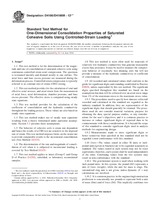
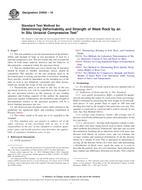 ASTM D4555-10
ASTM D4555-10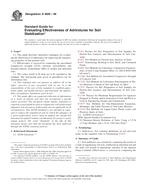 ASTM D4609-08
ASTM D4609-08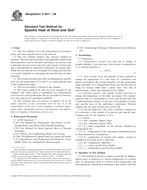 ASTM D4611-08
ASTM D4611-08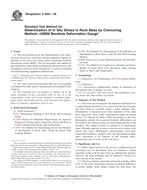 ASTM D4623-08
ASTM D4623-08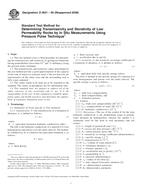 ASTM D4631-95(2008)..
ASTM D4631-95(2008).. ASTM D4647/D4647M-13..
ASTM D4647/D4647M-13..
 Cookies
Cookies
